Achieving 30 Percent Efficiency in Solar Panels for Enhanced Energy Conversion
Understanding Solar Panel Efficiency A Focus on 30% Efficiency Technology
Solar energy has emerged as one of the most sustainable sources of power in recent decades. With the growing concerns over climate change and environmental degradation, the development of efficient solar panels has become a priority for researchers and manufacturers alike. Among the most discussed advancements in this field is the promise of solar panels achieving a remarkable 30% efficiency rate. This article delves into the concept of solar panel efficiency, what a 30% efficiency entails, and its implications for the future of renewable energy.
What is Solar Panel Efficiency?
Solar panel efficiency refers to the percentage of sunlight that a solar panel can convert into usable electricity. For instance, a solar panel with 20% efficiency will convert 20% of the solar energy it receives into electrical energy, while the remaining 80% is lost as heat or reflection. Factors influencing efficiency include the materials used, the design of the solar cells, and environmental conditions such as temperature and shading.
Historically, traditional silicon-based solar panels have achieved efficiencies ranging from 15% to 22%. However, advances in technology are now paving the way for installations capable of harnessing more energy from the same amount of sunlight. Achieving a 30% efficiency rate represents a significant leap forward and could revolutionize the solar energy landscape.
The Significance of 30% Efficiency
Reaching a 30% efficiency threshold could have profound implications for solar energy adoption worldwide. Firstly, higher efficiency means that less space is required for solar installations to produce the same amount of electricity. This is particularly crucial for urban areas where land is limited and the demand for power continues to rise. More efficient solar panels could allow for the installation of solar systems on rooftops, small lots, and regions where traditional solar farms would likely struggle to fit.
Moreover, higher efficiency translates to more cost-effective energy production. As the efficiency of solar panels increases, the overall cost of solar energy per watt decreases. This reduction can make solar energy more competitive with fossil fuels, encouraging broader adoption and investment in renewable energy sources. With a 30% efficiency rating, solar panels will not only provide economic benefits but also contribute significantly to reducing greenhouse gas emissions.
solar panel 30 efficiency

The Technology Behind 30% Efficiency
To achieve a 30% efficiency rating, researchers are exploring various technologies. One of the most promising advancements involves the use of multi-junction solar cells. Unlike traditional single-junction silicon cells that only absorb a specific part of the solar spectrum, multi-junction cells are composed of multiple layers of different materials, each designed to capture different wavelengths of light. This design allows for a much higher rate of solar energy conversion.
Another approach involves the integration of advanced materials such as perovskite solar cells. Perovskites are a new class of materials that have shown tremendous potential in increasing efficiency due to their unique properties, such as tunability and ease of manufacturing. Pairing perovskites with existing silicon cells in tandem structures has led to reports of efficiencies exceeding 30%.
Challenges and Future Prospects
While achieving 30% efficiency holds great promise, there are several challenges that must be addressed before widespread adoption can occur. The production process for advanced solar cells can be more complex and costly than that of traditional cells. Furthermore, ensuring durability and stability, particularly in varying environmental conditions, is essential for commercial viability.
Another significant hurdle is scalability. As the technology matures, it must be manufactured at a scale large enough to meet global energy demands, all while maintaining affordability.
Conclusion
The pursuit of solar panel efficiency, particularly the ambitious goal of 30%, stands as a testament to human ingenuity in addressing energy challenges. As researchers continue to innovate and push the boundaries of solar technology, we inch closer to a future where solar energy plays a dominant role in our energy ecosystem. A shift to higher efficiency solar panels could not only transform renewable energy access but also contribute to a more sustainable and environmentally responsible world. By investing in and supporting these advancements, we can ensure a brighter future powered by the sun.
-
Unlocking Energy Freedom with the Off Grid Solar InverterNewsJun.06,2025
-
Unlock More Solar Power with a High-Efficiency Bifacial Solar PanelNewsJun.06,2025
-
Power Your Future with High-Efficiency Monocrystalline Solar PanelsNewsJun.06,2025
-
Next-Gen Solar Power Starts with Micro Solar InvertersNewsJun.06,2025
-
Harnessing Peak Efficiency with the On Grid Solar InverterNewsJun.06,2025
-
Discover Unmatched Efficiency with the Latest String Solar InverterNewsJun.06,2025







